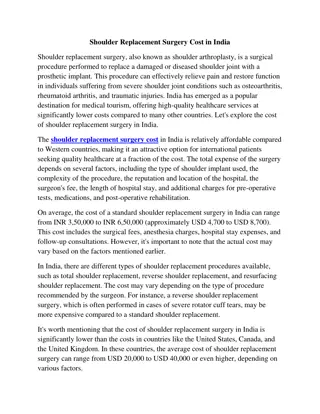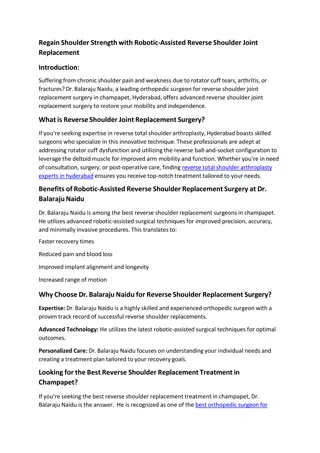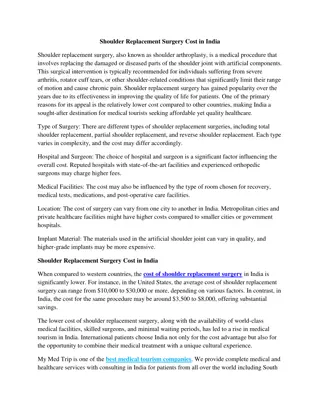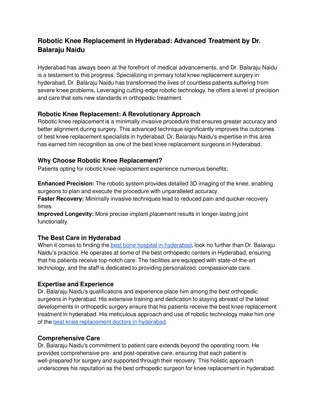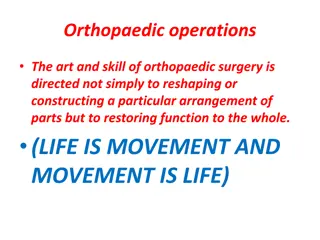
Understanding Arthroplasty: Joint Replacement Surgery Explained
Learn about arthroplasty, a joint replacement surgery commonly performed on the hips and knees. Discover who needs arthroplasty, what joints orthopedic surgeons replace, pre-surgery preparations, and post-surgery care. Explore the advantages, potential complications, and the longevity of joint replacements.
Download Presentation

Please find below an Image/Link to download the presentation.
The content on the website is provided AS IS for your information and personal use only. It may not be sold, licensed, or shared on other websites without obtaining consent from the author. If you encounter any issues during the download, it is possible that the publisher has removed the file from their server.
You are allowed to download the files provided on this website for personal or commercial use, subject to the condition that they are used lawfully. All files are the property of their respective owners.
The content on the website is provided AS IS for your information and personal use only. It may not be sold, licensed, or shared on other websites without obtaining consent from the author.
E N D
Presentation Transcript
StudyMafia.Org Arthroplasty Submitted To: Submitted By: Studymafia.org Studymafia.org
Content Definition Who needs arthroplasty? What joints do orthopedic surgeons replace? What happens before arthroplasty? What happens after arthroplasty? Advantages Complications How long do joint replacements last?
Definition Arthroplasty, or joint replacement surgery is performed most frequently in the hips and knees, and involves the complete removal of the damaged joint and tissues to be replaced with an artificial prosthesis. The goal of the procedure is to relieve pain and restore a sense of normal function and mobility into the damaged joint. Joint replacement surgeries are recommended for patients experiencing severe pain and disability as a result of progressive arthritis.
Who needs arthroplasty? Your surgeon may recommend arthroplasty if you have: Joint pain that hasn t gotten better with nonsurgical treatments such as physical therapy (PT), medications, bracing, injections, walking assistive devices and rest. Joint stiffness and limited mobility that make it difficult or impossible for you to do your everyday activities. Swelling (inflammation) that doesn t improve with medications or lifestyle changes.
These symptoms can result from several conditions, including: Arthritis, specifically osteoarthritis. Rheumatoid arthritis. Fractures, including a hip fracture. Joint abnormalities, such as hip dysplasia. Avascular necrosis (lack of blood supply to the bone).
What joints do orthopedic surgeons replace? Most often, surgeons replace the hip joint, knee joint or shoulder joint. Providers call these procedures hip arthroplasty, total knee arthroplasty and shoulder arthroplasty. In the United States, surgeons perform about 500,000 hip replacements and more than 850,000 knee replacements every year. Currently, surgeons can replace all of the following joints: Ankles. Elbows. Hips. Knees. Shoulders. Toes. Wrists.
What happens before arthroplasty? Your provider will help you prepare for the procedure. They may recommend physical therapy, exercise or a diet program for you to follow in the weeks leading up to surgery. These programs can ensure that you re healthy for the operation. Before arthroplasty, you may need several tests to evaluate your overall health such as blood work, an electrocardiogram and a chest X-ray. Depending on your health history, you may need to visit your primary care provider or another specialist for pre-operative evaluation. Some procedures require a CT scan or MRI for surgical planning.
Tell your provider about your health history and any medications you take. You may need to stop taking certain medications (such as blood thinners) before surgery. Your provider will tell you what time to stop eating and drinking the night before your procedure.
What happens after arthroplasty? After surgery, you will feel some pain. The first few days after your procedure, you should: Avoid physical activity. Take time to rest as you recover from surgery. Your provider may recommend placing ice or a cold compress on the new joint for about 20 minutes at a time. Perform your physical therapy and home exercise program as prescribed. It is important to follow your provider s instructions. They will not only help in your recovery to restore function but also help to protect the new joint.
Elevate. Depending on the joint you had replaced, your provider may recommend keeping the joint elevated while you rest. For example, if you had a knee replacement, rest with your foot on a stool or chair instead of the floor. Keep your incisions clean and covered. Follow your provider s incision care instructions carefully. Ask your provider when you can remove the dressing, take a shower or bathe after your procedure. Take pain medication. Your provider may recommend over-the-counter nonsteroidal anti-inflammatory drugs (NSAIDs) or prescription pain medication. Be sure to follow your provider s instructions when taking pain medication. You may also need drugs to reduce swelling or prevent blood clots.
Advantages Joint replacement procedures can help you move without pain and stiffness. After a joint replacement, many people can take part in activities they once enjoyed. These surgeries greatly improve quality of life and overall health by allowing people to have an active lifestyle.
Complications As with any surgery, there is a risk of complications from arthroplasty. The risks include: Blood clots. Infection. Injury or damage to nerves around the replaced joint. Joint stiffness, weakness or instability that may lead to a fracture. Problems with the new joint, including dislocation. You have a higher risk of complications from arthroplasty if you have certain health conditions. Before surgery, tell your provider if you have diabetes, hemophilia or an autoimmune disease such as lupus. These conditions can make recovery from joint replacement more difficult.
How long do joint replacements last? A new joint usually lasts about 10 to 15 years. But everyone has different results after arthroplasty. Talk to your provider about what you can do to take care of your new joint. If your joint replacement wears out after 15 years, it may be possible to revise it with a new joint.
Thanks To StudyMafia.org



